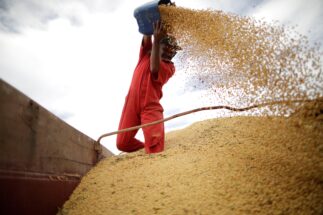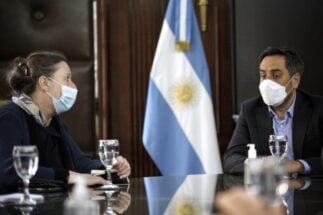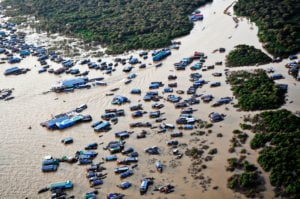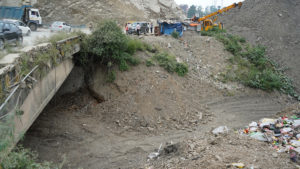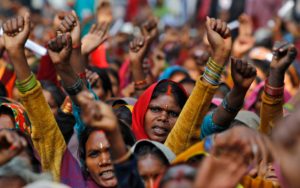As governments beavered away for two weeks at COP26 in Glasgow to finalise the rules for implementing the Paris Agreement to limit global warming to 1.5ºC, campaigners outside the venue voiced deep frustration at progress they felt was too slow for those at the sharp end of increasingly extreme weather events.
Held a year later than planned as countries slowly emerged from the Covid-19 pandemic, shows of increased ambition at COP26 to mitigate greenhouse gas emissions and negotiate climate finance, loss and damage and rules for carbon trading – longstanding roadblocks to the talks – were long overdue, protesters argued.
Inside the vast Scottish Event Campus, there had been some successes prior to talks wrapping up on Saturday, a day later than scheduled. The US and China reaffirmed their commitment to cooperate on the climate crisis, a global carbon market inched closer to reality, and rich countries agreed to boost spending for developing countries’ climate fight.
But with unmet promises on finance from ten years ago, many were still sceptical. On the streets, Extinction Rebellion and youth group Fridays for Future were among those holding impassioned street demonstrations seeking urgent political solutions to the crisis. A crooning geoengineering advocate dressed as Darth Vader, meanwhile, found temporary fame by dancing to bachata and swapping 80s pop lyrics with proposed technological solutions.
Lord Vader has plenty of positive energy this morning at #COP26
(But he is here, er, advocating for solar geoengineering)#DeathStar pic.twitter.com/jU0YaiPx0x
— Leo Hickman (@LeoHickman) November 10, 2021
Eventually, countries signed the Glasgow Pact, albeit after a late intervention from India that threatened to derail it by watering-down a pledge to phase-out coal that left COP26 President Alok Sharma on the brink of tears.
For Latin America, the two-week summit left an array of climate commitments that they will now have to implement. But it also underscored the many tough questions the region still has to answer, from its pipeline fossil fuels projects to emissions reductions from the agricultural sector.
Latin America’s climate coalitions
At COP26, Latin American governments agreed on a call for further funding from developed countries to reduce their emissions and adapt to the impacts of a faltering climate.
For Colombia, Uruguay and Argentina, this meant a request for new finance instruments linked with environmental targets, such as debt-for-nature swaps. Uruguay also announced a new sovereign bond that will pay a lower interest rate if its climate targets are met as Azucena Arbeleche, the country’s Economy minister, tried to convince international financial institutions to apply similar criteria. Argentina also appealed to the International Monetary Fund to factor-in climate performance amid its debt restructuring.
The only way for [Brazil’s] pledges to be enacted is for Bolsonaro not to be in office. The upcoming presidential election will be a choice between the Amazon and Bolsonaro
“The call for further funding is the only issue in which the region has a common position, considering that Latin America is highly vulnerable to the effects of the climate crisis,” said María Laura Rojas, head of the NGO Transforma. “On other issues, nevertheless, there are important differences between governments.”
Latin American countries unite around certain common interests at climate talks and negotiate in various, often overlapping, blocs.
There are eight that form the Independent Alliance of Latin America and the Caribbean (AILAC), for example, which published a letter at the end of COP26 calling for further funding and greater ambition. Bolivia and the ALBA group that includes Cuba, Nicaragua and Venezuela, highlighted their rejection of carbon markets they say were proposed and developed by rich countries. Meanwhile, Argentina, Brazil, Uruguay and Paraguay, which have struggled to reach consensus on trade within the Mercosur bloc, pledged to work together, focusing on supporting the agricultural sector amid calls for further emissions reductions.
“The most important issue in the climate crisis is energy emissions, but if countries want to reach carbon neutrality they will have to ask themselves difficult questions, including the role of agriculture,” said Enrique Maurtua Konstandinidis, senior climate adviser at the Argentine NGO FARN. “The world is entering a transition and choosing other products.”
Pledges at COP26
Brazil presented environmental pledges that appear ambitious, among them a “Green Growth” programe, which the government said would attract investments and generate sustainable jobs. Alongside more than 100 countries, Brazil also signed a pledge at COP26 to halt forest loss and restore degraded by 2030 – a promise already made by UN member states in Sustainable Development Goal 15.2, by 2020.
5%
the increase in Amazon deforestation in October compared to the same month last year - a record high
But Latin America’s largest economy faced accusations of ‘greenwash’ by critics as it unveiled pledges at its glossy Brazil pavilion adorned with artificial foliage and the logo of CNA, the national federation of agriculture and livestock. Bolsonaro’s rhetoric and his worsening record on forest protection was brought into sharp contrast during COP26 as official data showed deforestation rising by 5% in October compared with the same month last year, an all-time high since the Deter monitoring programme was launched in 2016.
“We all know that what Brazil presented at COP is not what’s really happening in the country,” Marcio Astrini, executive secretary of Brazil’s Climate Observatory, told Diálogo Chino. “The only way for the pledges to be enacted is for Bolsonaro not to be in office. The upcoming presidential election will be a choice between the Amazon and Bolsonaro.”
Although Bolsonaro didn’t travel to Glasgow, Brazil’s state governors did, pledging to implement the country’s climate plans irrespective of the federal chief in Brasilia. Other Latin American presidents attended the first days of the summit, including Iván Duque (Colombia), Guillermo Lasso (Ecuador), Luis Arce (Bolivia), Alberto Fernández (Argentina) and Carlos Alvarado (Costa Rica). Speaking at the plenary, they highlighted previous commitments and made new ones.
Lasso announced a new marine protected area (MPA) around the Galápagos Islands, extending for 60,000 square kilometres, to be funded by a debt-for-nature swap – the largest ever, he argued. Duque also introduced new MPAs for Colombia, adding 160,000 square kilometres to an already protected area.
Costa Rica, Colombia, Ecuador and Panama presented a plan to connect their MPAs in a single corridor that will serve as one of the world’s richest pockets of ocean biodiversity. It will be a fishing-free corridor covering more than 500,000 square km, in one of the world’s most important migratory routes for many species.
A group of 109 countries, including Argentina, Uruguay, México, Brazil and Uruguay, also signed a commitment to reduce their methane emissions by 30% between 2020 and 2030. Methane is a powerful greenhouse gas released into the atmosphere through human activities, notably livestock production.
“Climate-smart livestock production not only has environmental advantages but it also gives farmers a larger profit. Our country can have a leading role in this,” Adrián Peña, Uruguay’s Environment minister, told Diálogo Chino. “Signing the methane emissions pledge made total sense. Why wouldn’t we sign it if we are already working on this?”
Decarbonisation pathways in Latin America
As part of the Paris Agreement on climate change, countries have to build a roadmap to reach the mid century with decarbonised economies. For Latin American governments, this means making difficult, long-term economy-wide plans, covering energy, agriculture and beyond.
51%
Colombia's 2030 emissions reductions goal, up from 20%
Alongside a boosted emissions reduction pledge of 51% by 2030, unconditional on financial assistance and compared to its former goal of 20%, Colombia officially launched its long-term plan to reach carbon neutrality by 2050. It includes actions on forest protection, sustainable consumption and production, rural development, resilient cities, diversified energy sources and electric mobility.
“If we want to be carbon neutral we have to stop deforestation, improve the management of agricultural land and rely less on fossil fuels,” Colombia’s environment minister Carlos Correa said at the summit. “Those are the key areas to reduce our emissions so then through our biodiversity and reforestation we can be carbon neutral.”
However, the country now finds itself with the challenge of quantifying the costs of its emissions reductions plans and working with international partners to achieve them, Alex Saer Saker, director of climate change and risk management at Colombia’s environment ministry, told Diálogo Chino.
“It’s really key because it’s not just resource cooperation but also technical cooperation,” he said, pointing out that researchers from organisations including the Stockholm Environment Institute were crucial in calculating emissions and achievable cuts. “It’s a need for all our countries that maybe don’t have the expertise to come up with the numbers,” he added. Saer also highlighted changes in bid processes for renewables projects and tariff reductions on electric vehicle imports as vital elements that enabled Colombia to follow Costa Rica and commit to decarbonising.
Although the final Glasgow text failed to outrule the use of coal power, Saer recognised that COP26 echoed strong signals on the future of a commodity that Colombia relies on for export revenues. “All the actions countries have been taking in terms of coal use will change the market. These companies that export coal will need to identify other business sources and diversify,” he said.
Chile also announced its long-term strategy at COP. The country hopes to have a zero-emissions energy matrix by 2050, as well as slashing emissions from the mining and industrial sector by 70% and introducing recovery and conservation plans for 30 to 50% of threatened species.
Alongside Uruguay, Chile also signed a declaration at the summit to work towards all sales of new cars and vans being zero emissions by 2040. Costa Rica also started a new coalition with a group of 11 other countries to work to end new concessions, licensing or leasing rounds for oil and gas production.
Argentina was expected to present its roadmap for 2050 too, but decided to delay it amid lobbying by agricultural groups before the summit. Instead, the government made its 2% improvement in the 2030 target official. The government is boosting investments in the fossil fuel sector as new renewable tenders are put on ice.
Next year’s climate summit will take place in Sharm El-Sheikh, Egypt and campaigners hope key issues of adaptation and loss and damage will get the urgent attention and progress required. Latin American and other governments will need to come back with improved climate commitments, showing a world hit by increasing droughts, floods and rising sea levels, they have the strategies and the will to raise their game.


